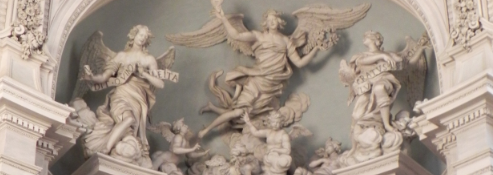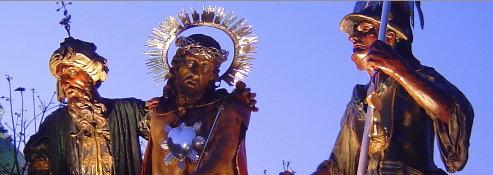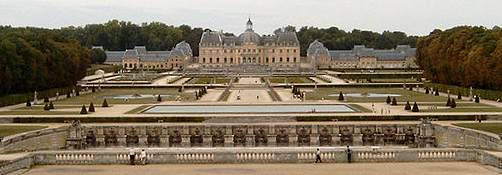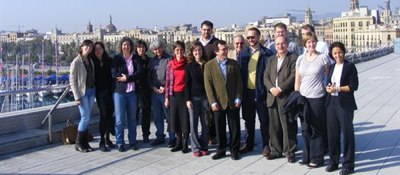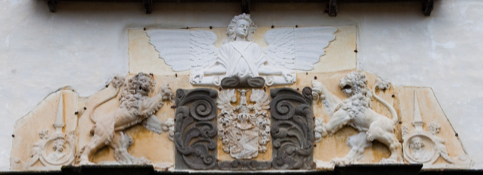From the point of view of the history of literatures of the successor states established after the disintegration of the Hungarian Kingdom, [2] the three volumes of 122 eulogies in total (44+28+50) written in lapidary style by the Slovakia-born Jesuit Stephanus Tarnoczy [3] (1626-1689) in praise of the royal patron saints of the Hungarian Kingdom represent an outstanding example of this literary genre, very popular in the Baroque period. [4] [fig. 1 - 3] Recently, M.-E. Ducreux has proposed a concept of the Pietas Hungarica, [5] parallel to that of the Pietas Austriaca formulated by A. Coreth, [6] in which the cult of the Holy Kings of Hungary played a crucial role. [7] This paper is meant to highlight especially one particular aspect of the mentioned "pietas", namely that of its polemical-theological context.
Before turning my attention to the works of Stephanus Tarnoczy SJ, I examined a series of thirty-nine panegyrical orations dedicated to St Ladislaus dating from the years 1655 to 1693. [8] These orations were delivered annually by designated speakers at St Stephen's Cathedral in Vienna on the occasion of the feast day of St Ladislaus, the patron saint of the 'Hungarian' university nation, often in the presence of Emperor Leopold I. The panegyrics were made to order and followed a uniform theopolitical pattern. As such, being part of a larger festivity, they probably functioned as an efficacious means of political propaganda at the university of Vienna which represented the most important educational centre of Hungarian nobility in the seventeenth century. I attempted to interpret the Viennese panegyrics by means of three interpretative keys: J. E. Nieremberg's version of the idea of a Christian prince, F. Pomey's rhetorical precepts concerning the praise of a male princely person, and G. Stengel's theory of imitation. In the following, I would like to offer some observations as a continuation to and a broadening of the view taken in the case of the Viennese panegyrics.
Stephanus Tarnoczy's eulogies came into being in a context different from the one outlined above. Their author was neither obliged nor commissioned to compose his elogia. [9] While the mentioned Viennese panegyrics on St Ladislaus were regularly dedicated to Emperor Leopold I and a majority of them referred to Leopold as representing a living image of Ladislaus's virtues on earth, [10] Tarnoczy dedicated his eulogies to Paulus Eszterhazy de Galantha (1635-1713), the future palatine (vice-king) of Hungary (the first two volumes), and to Sylvester Joanelli/Giovanelli (1631-1685), a magnate and mining entrepreneur in the north-eastern part of present-day Slovakia (the third volume). The dedicatees are praised by the author as those who embody the virtues and the deeds of the Holy Kings, thus taking on a role similar to that of Emperor Leopold in the Viennese panegyrics. Like all the Baroque panegyrical writings on the Holy Kings of Hungary, Tarnoczy's eulogies are extremely difficult to interpret because they refer to different contexts - political, religious, historical, patriotic - and as such they should be considered within different frames of reference. The more contexts we take into account the more authentic understanding we achieve. In this paper, I focus on the reference frames of polemical theology and political thought, trying to show their mutual interrelatedness and suggest some implications for interpretation ensuing therefrom.
The overall situation of the Hungarian Kingdom in the second half of the seventeenth century was mainly determined by three factors: anti-Turkish warfare, anti-Habsburg uprisings and the progress of recatholisation. These aspects manifested themselves abundantly in the local literary culture of the period. On the Catholic side, it was constantly emphasised that political unity and social concord in the country, which of course was of primary importance, could only be achieved by uniting the people in one faith. [11] Besides, the problem of political stability and religious concord became associated with patriotism and the common historical consciousness of the confessionaly divided Hungarian nobility. Both Catholics and Protestants imagined and defended the holy founder of their state, King St Stephen I, as one who was favourably inclined towards their own religion, whether Roman Catholic or Protestant. [12] This historical dimension of confessional polemics in Hungary was based on one of the fifteen signs of the true Church developed by Robert Bellarmine, namely the sign of antiquity. [13] In the 1680s Emperor Leopold I entrusted Cristóbal Royas y Spinola (1626-1695), bishop of Wiener Neustadt, with the authority to hold negatiations with the representatives of the Protestant churches in the Kingdom in order to win them back to Catholicism. [14] Although the project failed, it nevertheless gained some support among Protestants. Probably the most ardent advocate of the Catholic-Protestant union, Franciscus Fóris Otrokocsi (1648-1718), himself a convert from Calvinism, proposed in one of his latter works an interesting way of Catholic-Protestant reconciliation by that he drew attention to the formula of faith as it was recorded in the early eleventh-century Instructions of St Stephen, the first king of Hungary, addressed to his son St Emeric. [15] It was a good strategy because it was this very formula that, due to its very broad and general wording, had been used by Protestants to show that St Stephen's religion was free of Roman Catholic additions. [16] To illustrate this context even more explicitly, let me quote one of the most prominent controversialists of the Hungarian Kingdom, Martinus Szent-Ivany (1633-1705), who, in 1699, formulated the following question in his Quindecim dilemmata: "Were the Magyars and Pannonians at the time of King St Stephen, i.e. in the beginning of the eleventh century, converted from heathendom to the true Christian faith or were they not converted to the true Christian faith?". [17] The force of this dilemma comes from the assumption that the faith to which the predecessors of Hungarians were converted was, naturally, Roman Catholic, which, according to Protestants, was not the true Christian faith. Consequently, this would mean that all the forefathers of the Hungarian nobility, who made up the political nation of the country, would be eternally damned since they lacked true faith without which, in accord with the then generally accepted axiom, no one could be saved. It is evident from later reactions to this dilemma how outrageous this idea was to the Hungarians of that period. It is in this context, in the light of the Catholic-Protestant contest for the historical beginnings of their national identity, that the Baroque texts relating to the holy patron saints of the Hungarian Kingdom should be read.
Let me illustrate the polemical-theological context of Tarnoczy´s eulogies by a couple of examples. In his first book of eulogies (Idea coronata), Tarnoczy depicts St Stephen as one who showed great zeal for the conversion of souls and he does so in a most interesting way by adopting very up-to-date linguistic means of expression. Speaking of St Stephen's eagerness to win souls for Christ, he describes his method in these words:
He explains,
with the aid of divine light,
the motives of credibility
to those entangled in error
in order to deliver them from false doctrine. [18]
The motives of credibility or the marks of the true Church, [19] as they were also called, were the backbone of early modern Catholic polemical theology. Tarnoczy's eulogies were written in such manner as to conform also to this particular frame of reference. Christian perfection, the good works of prayer, fasting and alms-giving, miracles, union with the Roman Pontiff etc. are all concepts abundantly represented in the lines of Tarnoczy's eulogies.
Although Tarnoczy founded his royal biographies on historical evidence drawing on the standard works of Hungarian historiography (A. Bonfini, M. Inchofer), he nevertheless made ample use of poetic licence so as to render the Holy Kings more fitting with the contemporary categories of polemical-theological thinking. It is indeed interesting to observe how the mentioned Instructions of St Stephen to his son were creatively transformed in Tarnoczy's intrepretation. This is what St Stephen says about protecting the Chruch in the authentic text from the eleventh century:
If there be such a miserable person who scandalizes the members or the little ones of this holy Church, he deserves, according to the teaching of the Gospel, to have a millstone hung around his neck and to be drowned in the depth of the see, i.e. to be deposed from his dignity and remain outside the Church. Therefore, my son, you must be always on the watch so that the Church may thrive rather than incur damage. [20]
Tarnoczy refashioned this passage in his second book of eulogies (Princeps angelicus) adapting it to the late seventeenth-century circumstances:
Far away must be kept the Sects
that scatter the sheepfold
cutting it into fragments
so that they themselves become a fragment
and the rubbish of the Church.
To this end apply the power of your office to make them change their ways,
to this apply the executioner's axe to make them fear…
Heresy
is a distorted spiritual goverment;
use theopolitics in opposition to it. [21]
The Catholic political theology or, more particularly, the idea of a Christian prince was known in the territory of the Hungarian Kingdom mainly through two works on princely virtues, namely those written by Guillaume Lamormain [22] and Juan Eusebio Nieremberg. [23] As this context is certainly more familiar to the reader than that of polemical theology, I shall not enlarge on it at present. It is interesting to observe that polemical theology and political thought converge or overlap on several points. This is probably most evident in the idea of the mutual connectedness between a ruler's promoting of the true Church and the prosperity of his reign. In Bellarmine's treatise on the marks of the true Church, the fifteenth mark is defined as the temporal well-being of those who engage themselves in the defence of the true Church. Bellarmine says: Never did a Catholic prince adhere to God with all his heart without easily attaining victory over enemies. [24] Similarly, Nieremberg writes in his Virtus coronata: a peculiar fruit of a king's virtues is the opulence of his kingdom. [25] And again: A prince's virtue is of great import for his victories. [26] Note here that political thought and polemical theology approach the same problem from opposite perspectives: while the first proceeds from virtue to prosperity saying that a virtuous king guarantees the prosperity of his kingdom, the latter argues in reverse order maintaining that the temporal prosperity of a king is a sign of his true faith or, in other words, of his being a member of the true Church. Both these perspectives merge in Tarnoczy's elogia. Speaking of St Stephen's military triumphs, Tarnoczy says:
Stephen's sincere endeavours
were so close to Heaven
that they absolutely evaded the range of penitence.
This was recognized by Hungary
to whom Mars, under the protection of the Great Mother,
was always propitious.
But as soon as Hungary defected from the Mother,
nay, as soon as she became degenerate, the victorious Mars also
receded from her.
Do not ever expect to achieve victory
unless you worship Our Lady of Victory.
She was so deeply imprinted
on the heart of Stephen, the Marian king,
that wherever he set his martial foot,
he triumphed. [27]
The message of these lines is that virtue, or piety, always entails success, which is in complete accord with the idea of a Christian prince. However, the author goes much further by precisely indicating the character of that piety. The close relationship between the devotion to the Virgin Mary and military success is very strongly expressed in the anagrammatic pair Martem-Matris. [28] Another illustrative example of the overlapping of the polemical and political approaches is the concept of Christian perfection. One of the most prominent authors of Catholic apologetics, Leonard Lessius SJ, regarded the study of moral perfection as the first sign of the true religion:
That religion is to be preferred which promotes purity and sanctity of life, calling one's mind away from the affection for earthly things and leading it to the love of the heavenly. And such is only the Catholic religion. For this religion recommends afflictions of body by which desires are tamed and subdued to spirit. [29]
Juan Eusebio Nieremberg explains at the beginning of his Corona virtuosa what is meant by the virtue a Christian prince should possess:
What virtue confers on a prince, among other things, is that it lifts his spirit up to pursuing the more noble ways of virtue that by far surpass the mere immunity to sin. The royal dignity is the eye for the blind, the hand for the maimed, the leg for the lame, the strength for the weak, … it is love diffused over all. [30]
In his third book of eulogies (Rex admirabilis), Tarnoczy praises King St Ladislaus's endeavour to attain perfection using the following words:
In the midst of royal luxury,
you would call Ladislaus an ascetic rather than a king.
He adapted his noble body by fasting
to the narrow way that leads to Heaven.
(To the people) he was more amiable than a father.
For them he burned with love towards God
so that the Cherubim felt almost envious of him.
He even went to the altar
where he offerred himself
as a living token of penitence
in order to turn his people away from that which they might regret.
Therefore he offerred himself for the people
at the altar of the heart,
both the victim and the priest. [31]
Here, again, the perspectives of political doctrine and polemical theology are inseparably bound together. King St Ladislaus is, on the one hand, presented as an ascetic person practising acts of corporeal penitence while, on the other, he is said to offer all his sufferings for the people of his Kingdom. Similarly as in the previous example, the confessional aspect stands out very clearly, especially in that King Ladislaus is said to offer himself and to be the victim and the priest at the same time, which is an obvious likening to Christ. His endeavours are thus conceived of as part of Christ's work of redemption and his suffering is interpreted as substitutional suffering. Such a vision is only conceivable in the context of the Roman Catholic doctrine of faith. Evidently, the author depicted the virtues of the Holy King so as to conform to the reference frame of polemical theology, thus demonstrating the catholicity of the King. In both the examples, the context of political thought points to the ideal that had been represented by the Holy Kings of Hungary and was to be attained again and again in the course of Hungarian history, while the the context of polemical theology provides a proof that the original Hungarian models of that ideal were Roman Catholic.
Thus, in the light of the historical aspect of the Catholic-Protestant controversy mentioned above, the observations we have just made allow us to interpret Stephanus Tarnoczy's elogia on Sts Stephen, Emeric and Ladislaus as a vindication of the Roman Catholic origins of the Hungarian Kingdom. [32] One of the author's intentions obviously was to prove that the founders of the Kingdom and the originators of its constitution adhered to the Roman Catholic faith. And as the age of the Holy Kings was generally conceived of as the golden age of Hungary, their example and their (Roman) Catholic way of acting was held up as the model to be followed in order to regain the (supposed) harmony and prosperity of those early times:
O! may our homeland,
even till now miserably tossed about
in the ocean of Religion, War and Death that brings shipwreck so very often,
return to the bosom of the ancient Truth
and possess the secure tranquility again! [33]
Images
| 1a | 1b |
 |
 |
2

| 3a | 3b |
 |
 |
Notes
1. This paper is a partial result of the grant project VEGA 2/0170/12 "Polemical Theology and Its Contexts in Early Modern Slovakia".
2. I would like to point out that "Hungary" throughout this paper (and in historical contexts in general) is to be understood as denoting a much larger territory than the one indicated by the present-day meaning of the name. The case of Hungary is analogous to that of Belgium as it has been concisely described by Jozef Ijsewijn in his Companion to Neo-Latin Studies (Part I, Leuven 1990, p. 148: Since Belgium is now the English name of a much smaller kingdom, tremendous confusion is created by scholars and translators who render Latin "Belgium/Belgicus" by English "Belgium/Belgian". So doing the meaning of many humanist texts becomes completely distorted, if not absolute nonsense.)
3. I prefer to use the Latin names of early modern Hungarian authors. In the case of the multiethnic Hungarian Kingdom, using the vernacular forms of personal names in publications destined for an international audience causes great confusion since it often reflects present-day scholars' nationality rather than the real state of affairs in the past. Moreover, the use of different forms of names makes identification difficult.
4. S. Tarnoczy, Idea coronata sive vita S. Stephani primi regis et apostoli Hungarorum tenui calamo adumbrata, Viennae Austriae 1680; S. Tarnoczy, Princeps angelicus, sive vita S. Emerici ducis Hungariae, paucis elogijs expressa, Viennae Austriae 1680; S. Tarnoczy, Rex admirabilis, sive vita S. Ladislai regis Hungariae historico-politica, ad Christianam eruditionem elogijs theo-politicis illustrata, Viennae Austriae 1681.
5. M.-E. Ducreux, Emperors, Kingdoms, Territories: Multiple Versions of the Pietas Austriaca?, in «The Catholic Historical Review», Vol. 97, Num. 2, April 2011, pp. 276-304.
6. A. Coreth, Pietas Austriaca. Österreichische Frömmigkeit im Barock, Wien 1982 (Zweite, erweiterte Auflage).
7. However, the notion of "Pietas Hungarica", if it is to reflect the actual character of the 17th-century Hungarian piety, cannot be reduced only to the Holy Kings of Hungary. St Methodius, St Adalbert, St Andreas-Zoerardus and his disciple St Benedict, St Gerhard, St Elisabeth and others were all considered national patron saints of Hungary. The engraved title page of Melchior Inchofer's Annales Ecclesiastici Regni Hungariae (Rome 1655), displaying portraits of the most important figures constituting the foundations of Christianity in Hungary, is an excellent illustration of this fact. Also very instructive in this respect is the book of Hungarian saints Ungaricae sanctitatis indicia (Tyrnaviae/Trnava 1692) ascribed to G. Hevenesi or S. Tarnoczy.
8. S. Zavarský, Some Notes on I. F. X. Cetto's Collection of Thirty-Nine Panegyrics on St. Ladislas (Vienna, 1655-1693), in: M. HOMZA, J. LUKAČKA, N. BUDAK (Eds.), Slovakia and Croatia. Historical Parallels and Connections (until 1780), Bratislava-Zagreb 2013, pp. 372-380.
9. The Jesuits usually referred to their inscriptions (inscriptiones argutae) as elogium. Cfr. Ch. Weise, De poesi hodiernorum politicorum sive de argutis insriptionibus, Weissenfels 1678, p. 3.
10. It is very important to note with regard to the concept of the Pietas Hungarica that about a quarter of the Viennese panegyrics contains no allusion to Leopold I whatsoever. It seems the reference to the Hubsburg ruler was omitted intentionally in these cases.
11. For a better insight into this problem cfr. M. Szent-Ivany, Consultatio saluberrima de reducenda stabili ac constanti tranquillitate et pace in Hungaria per ejusdem adductionem in unitatem fidei ac religionis, Tyrnaviae 1704. This short treatise represents an outstanding example of this theopolitical course in the context of the Hungarian Kingdom.
12. This can only be understood in the context of the Catholic-Protestant debate concerning the much discussed question "Where were the Lutherans/Calvinians before Luther/Calvin?" Hungarian Protestants asserted that the form of Christianity which was propagated under the rule of King St Stephen in the beginning of the eleventh century was closer to the beliefs and practices of their church than to modern Roman Catholicism.
13. R. Bellarminus, De notis Ecclesiae, in «Disputationes de controversiis Christianæ fidei adversus huius temporis hæreticos», Tom. I, Contr. IV, Lib. I., Ingolstadt 1588 (second edition), col. 221.
14. Cfr. K. MASSER, Christóbal de Gentil de Royas y Spinola O.F. M. und der lutherische Abt Gerardus Wolterius Molanus. Ein Beitrag zur Geschichte der Unionsbestrebungen der katholischen und evangelischen Kirche im 17. Jahrhundert, Münster 2002, pp. 345-398.
15. F. Fóris Otrokocsi, Antiqua Hungarorum religio verè Christiana & Catholica, Tyrnaviae (=Trnava) 1706.
16. Cfr. e. g. Gratianus Rechabæus (= J. Kocsi), Malleus XV. dilemmatum quæ omnibus dominis acatholicis (evangelicos ita nominat) in Hungaria pro xenio novi anni 1699. affectuosissimè (juxta Gal. 4. 17.) quidam obtulit, Theopoli (= Debrecen) 1704, pp. 27-32.
17. Martinus Szent-Ivany, Quindecim dilemmata, omnibus dominis acatholicis in Hungaria, pro xenio novi anni M DC XCIX. affectuosissime oblata, Tyrnaviae 1699, Dilemma III: Hungari & Pannones tempore S. Stephani Regis ex Paganismo conversi, vel sunt conversi ad veram fidem Christianam, vel non? etc.
18. Tarnoczy, Idea coronata cit., Elogium XIV, p. 100: Motiva credibilitatis, / Ut ab errore demoveat incredulos, / Lucis divinæ operâ, / Explicat implicatis.
19. For the standard discussion on the marks of the true Church see R. Bellarminus, De notis Ecclesiae, in «Disputationes de controversiis Christianæ fidei adversus huius temporis hæreticos», Tom. I, Contr. IV, Lib. I., Ingolstadt 1588 (second edition).
20. Monita quibus Stephanus filium Emericum instruxit, in J.-P. Migne, Patrologia Latina, 151, col. 1238: Si quis infelix hujus sanctæ Ecclesiæ membra vel parvulos scandalizat, juxta Evangelii præceptum, dignus est ut mola suspendatur asinaria in collo ejus, et demergetur in profundum maris (Matth. XVIII, 6), id est dejiciatur de potestatis dignitate, et maneat extra Ecclesiam justorum, in illa mundiali miseria, sicut ethnicus et publicanus. Ac per hoc, fili mi, ferventi studio debes invigilare in sancta Ecclesia, de die in diem, ut potius capiat augmentum, quam detrimentum patiatur.
21. Tarnoczy, Princeps angelicus cit., Elogium VIII, pp. 51-52: "Procul hinc arcendæ Sectæ, / Quæ septa dissipant, / Et in frusta secant, / Vt frustum fiant / Ecclesiæ rejectamentum. / Huc expedi fasces, ut corrigantur, / Huc secures, ut terreantur, …" and Elogium IX, p. 56: "Hæresis / Est depravata Spiritûs politia".
22. G. Lamormain, Ferdinandi II. Romanorum Imperatoris virtutes, Coloniae (=Köln) 1638.
23. J. E. Nieremberg, Virtus coronata, seu coronarum illustrata documentis, & exemplis imperatorum, ac regum ex augustissima et serenissima domo Austriaca et Hispana, Viennae Austriae (=Wien) 1675.
24. Bellarminus, De notis Ecclesiae cit., col. 283: … nunquam enim Catholici Principes ex animo Deo adhæserunt, quin facillimè de hostibus triumpharent.
25. Nieremberg, Virtus coronata cit., p. 68: Eximius fructus virtutum regiarum est opulentia Regni.
26. Ibid., p. 71: Succurrit virtus Principi in toga, & sago. Magnus quin etiam ad victorias momentum confert…
27. Tarnoczy, Idea coronata cit., Elogium XIII, pp. 299-300: At sinceri STEPHANI conatus / Adeò Cœlo erant affines; / Ut omnem pœnitudinis jactum eluderent. / Agnovit hoc Ungaria, / Quæ Martem, sub protectione Magnæ Matris, / Propitium semper habuit. / Ast ubi, â Matre defecit Ungaria, / Imò facta degener; etiam victoriosus Mars / Ab Ungaris recessit. / Nec sperate unquam victoriam, / Nisi Mariam colueritis de Victoria. / Hanc STEPHANUS Rex Marianus / Ita cordi infixam gerebat, / Ut ubicunque Martialem figeret pedem, / Ubique triumpharet.
28. For the hidden significance of names and words in Neo-Latin texts cfr. H. Helander, Neo-Latin Literature in Sweden in the Period 1620-1720, Uppsala 2004, pp. 453-474, on anagrams especially pp. 454-462.
29. L. Lessius, Quæ fides et religio sit capessenda consultatio, Pragæ 1610, p. 11-12: Ea Religio præferenda quæ fauet puritati & sanctitati vitæ, quæ ab affectu terrenorum mentes auocat, & ad cœlestium amorem traducit … At talis est sola Religio Catholica. Hæc enim… suadet corporis afflictiones, quibus caro dometur, & spiritui subijciatur.
30. Nieremberg, Virtus coronata cit., p. 7: Etiam illud virtus confert Principi, quod … erigat imperantis animum ad sectanda augustiora bonæ mentis, quæ longè exsuperant solam â peccatis immunitatem. And p. 4: Regia dignitas… est oculus cæco, manus manco, pes claudo, robur infirmo … charitas in omnes diffusa.
31. Tarnoczy, Rex admirabilis cit., Elogium XXV, pp. 223-228: Inter Regias delicias LADISLAUM, / Ascetam diceres, non Regem. /… Augustum corpus ad angustam / Cœli viam jejuniis aptabat. / … Sed Patre amabilior. / Pro quo ita ardebat DEO, / Ut Cherubinis propè invidiam faceret. / …Ad aras usque processit; / Ubi se in victimam cædebat / Vivum pœnitudinis monumentum; / Ut suos à pœnitendis averteret. / … Ideo ad cordis aras seipsum / Pro populo immolabat, / Idem victima, & Sacerdos.
32. In later debates during the 18th century, Protestants strived to deny the Roman origins of Hungarian Christianity by trying to prove historically that the beginnings of the Christian faith among Hungarians were connected with Byzantium.
33. Tarnoczy, Idea coronata cit., Pars I, Elogium XIV, p. 103: O! utinam, etiam nunc in tam naufrago / Religionis, Martis, & Mortis Oceano, / Tam miserè fluctuans Patria, / In sinum pristinæ sisteretur Veritati! / Ac securæ redderetur tranquillitati!





